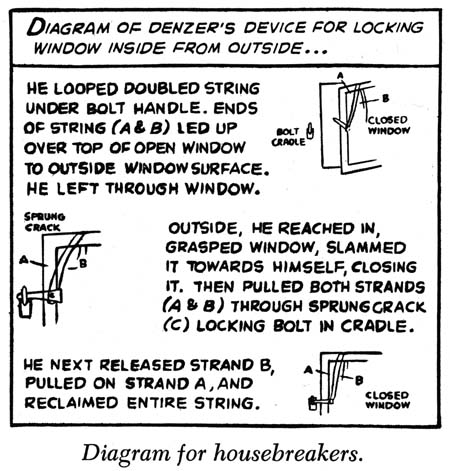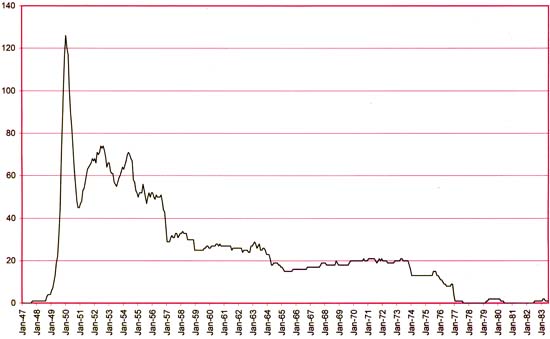It is not much, but Titan has a little announcement about their Simon and Kirby books on their web site.
Category Archives: Topic
Fredric Wertham’s “Seduction of the Innocent”
In a recent post I showed that data suggested that the cause of the decline of comics in the mid 50’s could be attributed to the effects of Fredric Wertham’s book “Seduction of the Innocent” (1954). This issue is of importance not only to the history of comics in general but also to the break up of the Simon and Kirby collaboration. I had also previously reviewed David Hajdu’s book “The Ten Cent Plague” which traced the history of the anti-comic campaign. Historical books are important but I also felt that a reading of the seminal “Seduction of the Innocent” itself was in order.
I really had no idea what to expect. Of course I knew about how down right silly some of his conclusions sounded such as that Batman and Robin projected a homosexual relationship. I had also understood from second hand sources that Wertham really did not have scientific evidence to backup his claim about the link between comic books and juvenile delinquency. But the whole idea of reading this book was to allow Wertham to in effect plead his own case and so I tried to keep an open mind while I read it.
As I said I really did not know what to expect but I never thought I would find this book so poorly written. Wertham was a psychiatrist some of whose writings were included in medical and scholarly journals. I knew that “Seduction of the Innocent” was written for the general public but I still expected a well ordered and reasoned presentation. Instead I found it filled with histrionics and that Wertham’s train of thought seemed to wander erratically. There was an overall structure provided by the chapters but within a paragraph it could frequently seem like a stream of consciousness. Let me provide an example paragraph (pages 33 and 34):
This Superman-Batman-Wonder Woman group is a special form of crime comics. The gun advertisements are elaborate and realistic. In one story a foreign-looking scientist starts a green-shirt movement. Several boys told me that they thought he looked like Einstein. No person and no democratic agency can stop him. In requires the female superman, Wonder Woman. One picture shows the scientist addressing a public meeting:
“So my fellow Americans, it is time to give America back to Americans! Don’t let foreigners take your jobs!”
Admittedly this is a particularly egregious example in that each sentence seems to take the reader in a different direction. However disjointed paragraphs are found in great abundance throughout the book. As for the histrionics here is an example of the extremes he could go (pages 95 and 96):
What in a few words is the essential ethical teaching of crime comics for children? I find it well and accurately summarized in this brief quotation:
It is not a question of right, but of winning. Close your heart against compassion. Brutality does it. The stronger is in the right. Greatest hardness. Follow your opponent till he is crushed.
These words were the instructions given on August 22, 1939, by a superman in his home in Berchtesgaden to his generals, to serve as guiding lines for the treatment of the population in the impending war on Poland.
Literary criticism aside, what matters most is what points was Wertham trying to make, how well did he support his arguments and how creditable was he? My summary of the primary views found in “Seduction of the Innocent” would be:
- Comic books promote violence and crime in children.
- Comic books promote racism.
- Comic book can lead to impaired reading ability.
- Comic books desensitize their readers to good literature.
I am not saying these were the only issues but I feel they were the most important. For instance Wertham does raise the concern that romance comics may adversely affect sexual morals. But that occupies only a small portion of his writing and he seems much more concerned that the types of violence shown in comics toward women may lead readers to become sexually aberrant.
Undoubtedly for Wertham the most important criticism against comic books was the first, the connection between comic books and juvenile delinquency. Wertham believed that crime comic books promoted the criminals as the real heroes of their stories. That in particular the violence portrayed in the stories influenced the behavior of many youngsters. Further that crime comics gave instructions on how to actually commit crimes. Also that advertisements found in comics even provided the source from which youngsters could obtain weapons. Wertham’s classification of comics was not the same as commonly used today. For Wertham the crime comics also included westerns and superheroes. Any story that included a crime would be classified as a crime comic. For other reasons Wertham also criticized romance and horror comics as well. “Seduction of the Innocent” was not just a critique of comic books it was also a call for legislation action to ban all objectionable comics. As far as I can tell no category of comics completely escaped Wertham’s wrath. He even had complaints about some from the funny animal genre.
Wertham’s charges against comics were serious and, if true, a justifiable cause for action. So where did Wertham get the evidence to support his claims? Wertham placed much emphasis on his clinical studies. Wertham was a psychiatrist who did work in various clinics and hospitals. He also worked with children caught and subjected to the legal system. Wertham felt that clinical studies were the best method to determine the underlying reasons for the problems suffered by children and he was very critical of other study techniques. Another much used source of evidence could be considered as part of his clinical studies. It was the Hookey Club. This was something akin to group therapy where various children were brought together to discuss the individual member’s problems and come up with suggestions to help. The Hookey club acted as a sort of judge and jury and so it might be considered distinct from a more typical therapy group. Wertham would be present as well but he makes it sound like his actual participation was limited. The final important source of evidence was a study of the comics themselves.
So how creditable was Wertham’s arguments and, most importantly, his evidence? Although Wertham spends some pages describing various means of testing children (such as Rorschach Test) he does not explain how they were used to address the supposed connection between comic books and juvenile crime. Nor does he explain precisely what he means by clinical studies. Perhaps this lack is understandable in a publication for the general public However he does not supply any references for papers on the subject that he had written for some technical journal. As far as I have been able to determine Wertham never published any articles on his study of the comic book and juvenile delinquency in any journal of psychiatry or psychology. This is troublesome because while I might not understand his research methods well enough, I am also unable to see how his peers felt about his methodology either. In the end Wertham only has his authority as an expert to support his claim that his clinic studies prove the connection between comic books and juvenile delinquency. It bothered me while I was reading this book that time and time again when writing about others who disagreed with his findings Wertham would call for the scientific evidence that supported his critic’s position. Yet Wertham never truly supplied the evidence to back up his own claims.
Now I am far from an expert in Wertham’s field but I am going to hazard some observations nonetheless. I believe that what Wertham calls clinical studies is the understandings that he gained while treating patients. Now this might not be a bad approach for studying physical illnesses but for me it poses serious issues when it comes to mental problems. Treatment of mental problems does not go in one direction. It is not the patient supplying all the information nor is it the doctor doing the treatment based on his examination alone. Both the patient and the doctor take part in the process. With such give and take between the patient and the doctor how is it possible to be certain what is learned from the patient and what comes from the doctor’s preconceived notions? This does not seem like an objective methodology to me.
This concerns me because the comments that he reports coming from young patients often sound suspiciously like Wertham’s own views. I find the following statement by a member of the Hookey Club particularly suspicious (page 71):
You don’t have to think of it, it is in the back of your mind, in your subconscious mind.
May be I am wrong, but talking about “subconscious mind” does not sound like the terms that a youngster would normally use to me. This suggests that Wertham was more then just an observer at the meetings of the Hookey Club. If Wertham had influenced the Hookey Club in this way what other statements by Hookey Club members might what have actually been influenced by Wertham? Here is another example (page 192):
Like many other homoerotically inclined children, he was a special devotee of Batman: “Sometimes I read them over and over again. They show off a lot. I don’t remember Batman’s name…”
How creditable is it that someone who really so wrapped up in Batman would not remember his secret identity? More probable is that this member really was not that much of a fan but was saying what he thought Wertham wanted to hear.
The other area of evidence that Wertham used was from the comics themselves. Wertham said he made a careful and detailed study of comics and berated his critics for not having done so. Unfortunately Wertham frequently cited information about comics without identifying what comics the information was based on. This makes verifying some of his statements difficult if not impossible. And I do wonder how careful his studies of comic books were. For instance (page 106):
“You know,” the boy said, “what I really like is the Blue Beetle [a figure in a very violent crime comic book]. I read that many times. That’s what I dreamed about. I don’t have it at home; I get it at another boy’s house.”
“Who is the Blue Beetle?”
“He is like Superman. He is a beetle, but he changes into Superman and afterwards he changes into a beetle again. When he’s Superman he knocks them out. Superman knocks them out with his fist. They fall down on the floor.”
“If you say it is like Superman, how do you know it is?”
“I read the Superman stories. He catches them. Superman knocks the guys out.”
It is not difficult to understand that a child stimulated to fantasies about violent and sadistic adventures and about a man who changes into an insect gets frightened. Kafka for the kiddies!
But the boy’s description of the Blue Beetle turning back into a real beetle is completely inaccurate. Sure it is a child’s mistake but Wertham acceptance of it indicates he really was not that familiar with the character and therefore casts doubt as to how thorough his study of the original comic books was. Here is another (page 257):
This I am told has something to do with the Post Office regulations according to which they may change the name but must keep the number, to keep some sort of connection with the former product. So Crime may become Love; Outer Space, the Jungle; Perfect Crime, War; Romance, Science Fiction; Young Love, Horror; while the numbers remain consecutive.
Wertham’s book was published his book in 1954 at which time Young Love was still a running comic and one that never changed its name to Horror as he claims. If Wertham is so loose with his facts when trying to make this unimportant point how can he be trusted about other claims he makes about the actual comic books?
Wertham repeatedly claims that comic books provide instructions to youngsters on how to commit crimes. Note how the above comic book image taken from his book is titled by Wertham “Diagram for housebreakers”. Is it really? A careful reading shows that without a doubt it is showing how to lock a window not how to break in. As usual Wertham does not supply what comic he got this from. However I am pretty certain that this panel was from a murder mystery. The story would have been about a dead victim that had been found in a locked room; a not too uncommon plot device and not just found in comic books. The diagram would have been used at the end of the story to explain how the murder managed exit the room while leaving it locked. This technique would have been of no help to anyone wanting to commit breaking and entry.
Having finished “Seduction of the Innocent” I cannot help but wonder about the postscript. The Comic Code Authority completely changed comics. Crime comics did not last long. Horror comics became so innocuous that it seems strange to apply that name to them. I wonder what Wertham felt about the Comic Code? I suspect he was not happy. I believe that he wanted the elimination of all violence from comics and would have not approved of even the mild form that remained. That Superman could continue would probably been enough for Wertham to condemn the Code. Wertham believed that characters like Superman advanced racism and supported an almost fascist like view.
I also wonder what he would have felt about television. At the end of “Seduction of the Innocent” he does discuss the then new media. After his complete condemnation of comic books, it is surprising to read his glowing opinion of TV. Not that he thought it did not problems, but like so many other things he blamed that on the influence of comic books. Wertham felt that if that comic book influence could be removed that television would have a great positive affect. It must have been a bitter disappointment that after the Comic Code television did not flower as he predicted.
In summary there is reason to question what Wertham wrote in “Seduction of the Innocent”. My reading of this book leads me to my own prognosis of Wertham himself. I have full confidence in the intelligence of my readers and so I have no doubt that all will understand the technical term that should be applied to Wertham. He was a quack. There is no question that “Seduction of the Innocent” had a great impact at the time it was released. I just do not understand why. It got lots of reviews but did anybody actually read it? This book is so seriously and obviously flawed I am amazed that people were taken in by it. I can only surmise that people were so impressed by Wertham’s credentials that they were willing to believe what he had to say based on his authority as an expert.
Fortunately Fredric Wertham’s “Seduction of the Innocent” has become nothing more then a cautionary footnote in the pages of history. Wertham is fully discredited even by those who do not share my view that he was responsible for the decline of comic books. Or is he? Next on my reading list is “Fredric Wertham and the Critique of Mass Culture” by Bart Beaty (2005). My understanding is that this book attempts to restore Wertham’s image. I am sure I will have something to write about when I have finished that book.
Recreation Vs. Restoration, How Should Reprints Be Done?
Not long ago Daniel Best wrote a post on his blog about art recreations used in Marvel Masterworks (Original Art Stories: Marvel Masterworks Non-Original Artists). The gist of his comments was that he objected to Marvel’s use of recreated art in the Masterwork volumes. Mike Kelleher who does work for Marvel reprints posted a reply on the Marvel Masterworks Fan Site. The ensuing thread is typical of the sort of thing to be found in lists. It ranges from insightful discussion to meaningless name calling.
I have to give Mike Kelleher credit; he is open about what he has done. Apparently he felt quite justified in recreating art in some cases:
Marvel never gave me any instructions on how to recreate art. There is no way anyone could have known I redrew some of the pages on paper first before reconstructing them. My first 6-12 months of art recreation was done digitally, I then read an article somewhere ( might have been here but I don’t recall ) about how artists used to, and still do, literally redraw the pages for reprint purposes. Since I wasn’t happy with the results I was getting digitally, I decided to try drawing them (contrary to recent comments I am an accomplished, although unknown, artist :-). I’m still getting the feeling that some people are trying to attach sinister motives to this process, but there really are none.
He has an interesting post in the thread showing various stages in one of his reconstructions. Of particular interest to me was this statement:
Because Masterworks line art is printed 100% black just like the original comics, we need to digitally transform this image so that there is no grey. This is problem 1. There is no setting that will fill in the areas where the ink was light or dropped out completely. After playing with the adjustments for a few minutes I have decided that this is the best result I can get…
This explains the source of many of Marvel’s problems. Restricting the black plate to just line art was common in the original comics but is not typical of modern printing methods. In my opinion Marvels use of this technique in their reprints unnecessarily complicates the restoration process. With the level of correction that must be done the final results can be anything from a restoration to a recreation, depending on the person doing the work.
I found another of Mike Kelleher’s comments interesting:
Final points– All reconstructed artwork ( and most done from scans of stats and original art ) have some level of redrawn lines. Reality. Period.
This simply is wrong but I understand now why he believes it to be true. It is all back to that 100% black plate. Use a modern separation and you just cannot beat reproductions based on original art (assuming the original art is complete). I know original art is not always available so this is not a suggestion that Marvel take that approach.
In a previous thread on the same Marvel Masterworks Fan Site I learned from another that micro filch were used as the source for some of the golden age reprints. These micro filch were made many years ago but still occasionally show up in places like eBay. Their quality is fine for casual reading but as a source for reprints they leave much to be desired. Any reprint based on micro filch would almost certainly end up being a very poor recreation.
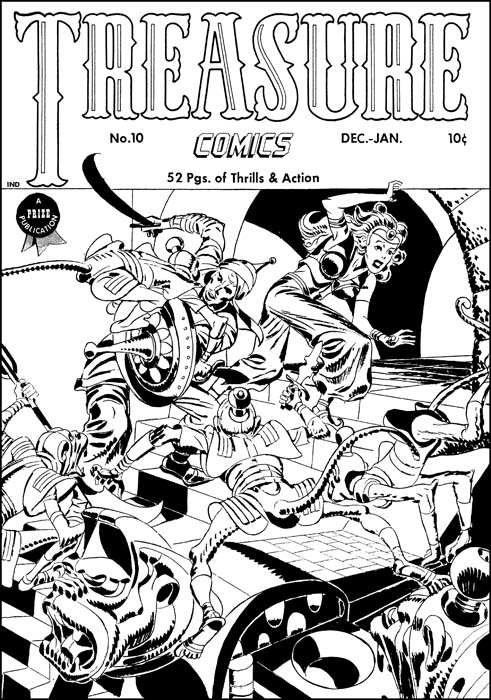
Treasure Comics #10 (December 1946), art by Jack Kirby
Years ago I decided digitally restore the line art for every Simon and Kirby cover. Even then I could not afford to chemically bleach the original comics. So I developed a method to remove the color using Photoshop. I must add that I am sure others have also figured how to do this on their own. Digitally bleaching is not as successful as with the use of chemicals so there was still a lot of work needed to clean up the final results.

Captain America #7 (October 1941), art by Jack Kirby (original scan)
Larger view
I did finish the project but in the end I came away with two basic realizations. One was this method required too much work. The second was that color really should be a part of the restoration process. I did not like Marvel reprints and felt there was a better and more accurate way of doing things. So once again I figured a process using Photoshop to do restoration. And yes I am sure others figured it out themselves as well. Usually I only post at least partially restored images in this blog, but now I will made an exception. The above image is an actually scan from a comic just as it came from my scanner. Below can be found my restoration based on that very scan. I was so pleased with my method that I once started a group (Digitizing Comic Books ). In that group I posted an explanation of some of my techniques. Well I do not think many got what I was trying to do so I never went past the basics. I am the moderator so there will be no problems if anyone wants to become a member. It is pretty much a dormant group but the archive still has my posts.
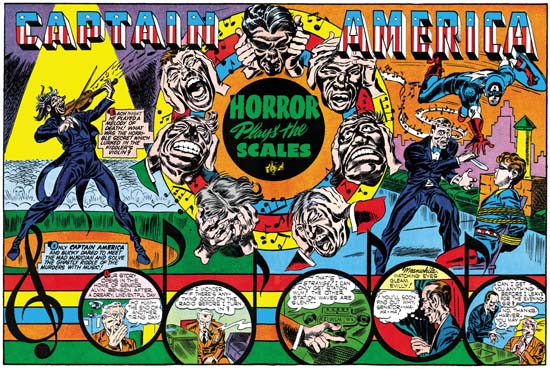
Captain America #7 (October 1941), art by Jack Kirby (restored)
Larger view
Is Marvel being dishonest by presenting recreations in a reprint volume? My original reaction was yes. Some on the thread have said that this was all well known facts. That it was not hidden in either Marvel interviews or posting on lists. I do not feel that is true discloser as not everyone reads those interviews or reads all comic book lists. So I pulled out my Marvel Masterwork volume of Daring Mystery. There in the table of contents they credit those who did the color and art “reconstruction”. Yes reconstruction is their word. My dictionary provides this definition of the word reconstruct:
“1) to construct again; rebuild; make over. 2) to build up, from remaining parts and other evidence, an image of what something was in its original and complete form”.
Well I feel the first definition is certainly valid for what Marvel has been doing (though not the second since the final result is nothing like the original form). So yes Marvel is being honest. I should have been more careful when buying these volumes because here reconstruct is another word for recreate.
There are those who honestly like Marvel’s approach and think the Masterwork volumes are the correct way to do reprints. They would not spend their money on what they would describe as just scans. There are also those who really are only interested in the characters and have little concern for studying the original artists and inkers. For all of them these Marvel Masterworks are a good deal. There are others who never did like what the glossy pages and flat colors of the Masterworks. There are also some who truly admire the earlier artists and want to see their art and not some recreation by a modern artist. For those the Masterworks just do not have the same value. I fall in this second category and I will be getting rid of the volumes I have and will not buy any more.
Goodbye Creig Flessel
During my visit with Joe Simon today we got the news of the passing of Creig Flessel. It saddened us both. Joe reminisced about Creig and George Tuska being part of his crew. Joe commented that they both were beautiful people. The three lived close to one another at that time. It is a period of Joe’s career that I have not studied sufficiently and so have not posted on yet. Not because it is less important then the rest of his career, but just because there is so many parts of his life that need to be studied.
I can recall a number of occasions during previous visits where Joe would pull out a copy of some commission piece that Creig had done recently. He never could get over how beautiful Creig’s work still was (nor could I).
Mark Evanier has a nice obituary for Creig Flessel. Ger Apeldoorn’s blog has a couple of posts with nice examples of Flessel’s commission work and other oddities.
One of Joe’s last comments before I left was “I am not ready to check in yet, I just ordered a couple of boxes of cigars”. In that case Joe, keep ordering those cigars.
A Date Without Romance
Most of the work that Simon and Kirby did for Hillman in 1947 was for previously existing titles. The sole exception was My Date. Despite its title, My Date was not a romance comic (as I discussed previously) instead it is teenage humor and in particular an Archie-clone. Archie first appeared as a backup feature in MLJ’s Pep Comics during the war while both Joe and Jack were in military service. Archie was so successful that MLJ’s superheroes were eventually dropped and the company’s name changed to Archie Comics. 1947 found Simon and Kirby looking for a work so it is not surprising that the popular Archie would lead them to suggest teenage humor title to Hillman. Although My Date was not a romance comic it clearly was directed at teenage girls. There would be a lot of dating in My Date but no romance.

My Date #1 (July 1947) “My Date with Swifty Chase”, art by Jack Kirby
The first story in all the My Date issues would be by Simon and Kirby. Initially the feature centered on Swifty Chase a good hearted young inventor. Like Archie there is a love triangle but in this case the center of it is the beautiful Sunny Daye and Snubby Skeemer is Swifty’s rich and unscrupulous rival. The first story has quite a cast of characters as can be seen in the splash. Three of them were clearly meant for this story alone; Humphrey Hogart, his fiance actress Chandra Blake and B. O. his business manager (the three are shown in the center background of the splash). The rest seem to be meant to be re-occurring cast members. However issue #2 introduced a new character, House-Date Harry, who would quickly become the feature’s lead character while Swifty would be delegated to a supporting roll. This is the equivalent of Jughead pushing out Archie. The Swifty Chase feature would be Simon and Kirby’s only contribution to the title and only the last issue would have more then one Swifty or House-Date Harry story.
Kirby’s drawing for My Date is surprising good. I say surprising because Jack is most famous for his more realistic portrayals. Yet the Swifty Chase stories are filled with visually interesting characters all done in a more cartoony style then is typical for Kirby although not as cartoony as his work at the same time in Punch and Judy. I wish I can be as complimentary about the writing. The first story is really a masterpiece. Lots of action and funny turns of events. Having Humphrey Hobart in it also helped. Things changed with the introduction of House-Date Harry. The idea of the scheming but good hearted Harry would have been fine as one shot story line. With the recurring use of the House-Date Harry theme it becomes forced and not nearly so funny. I really cannot see Simon and Kirby being able to continue to make this feature interesting.
Incidentally, I once wrote that the first use of a pin-up by Simon and Kirby was for Boys’ Ranch. Well I was wrong. I forgot about the pin-up found in My Date #3. It depicts Harry’s new house-on-wheels. It was printed to be viewed by rotating the page but perhaps it was originally meant to be a double page pin-up.
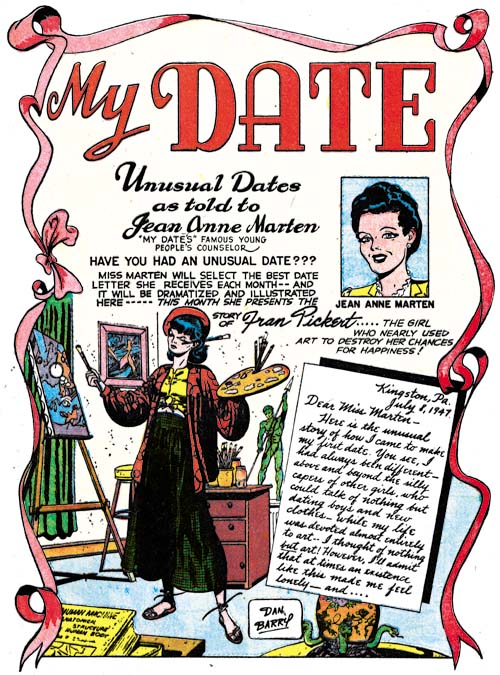
My Date #2 (September 1947) “My Date”, art by Dan Barry
Not only was there a feature “My Date with Swifty Chase” but there was also another simply titled “My Date”. Interestingly “My Date” uses the same ribbon border on the splash page that is found in “My Date with Swifty Chase”. The premise for the feature was the supposed true stories as told to Jean Anne Marten. But after reading these stories it is clear that they are fictional. The feature “My Date” was drawn by Dan Barry in issues #1 to #3 and by an unidentified artist in the final issue. At this time Barry was doing a bit of work for Hillman including Airboy and the Heap. Besides comic books, Dan would also do syndication work on Tarzan (1947 – 1948) and Flash Gordon (1951 – 1990). Joe Simon told me that Barry did work for him during the Mainline period. Originally I thought this was on Charlie Chan but when I showed Joe that art he said it was not done by Barry. So at this point I have no idea what work Dan Barry did for Mainline. Barry seems a good enough artist but I cannot get very excited about the work he did for My Date.

My Date #1 (July 1947) “Ginny”, art by unidentified artist
Another feature in My Date is “Ginny”. Nothing particularly outstanding about this feature, it was just another teenage group. The most unusual member was a cigar smoking girl with the name of Big Bertha. (Big Bertha was a heavy gun used by the Germans during World War 1). I have no idea who the artist was but it was the same one in all four issues. In terms of drawing skills this artist really was not more exceptional then other artists in My Date (of course excluding Kirby). What really distinguishes him is his use of panel layouts. These were much more imaginative then even those by Simon and Kirby in the “Swifty Chase” stories.
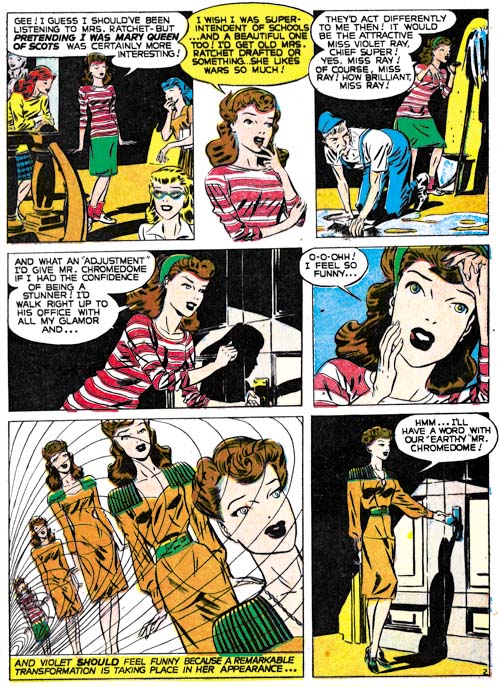
My Date #1 (July 1947) “Ultra Violet” page 2, art by Jerry Robinson? and George Roussos?
Perhaps the most unique feature in My Date was “Ultra Violet”. The lead character Violet has a very active imagination. But she is no Walter Mitty, her daydreams actually affect reality. In the sequence shown above, Violet transforms into a glamorous school superintendent (that sure sounds like an oxymoron). Her actions in that roll have repercussions even after she resumes her more ordinary existence. Another daydream reveals the truth behind a musical idol (he has false teeth and wears a toupee). I rather like the fact that no explanation is given as to how she is able to achieve such transformations.
The first Ultra Violet story is unsigned. When writing in this blog I prefer to record my current opinions even when they are very tentative and in need of further investigation. Such is the case here where I feel the art looks very much like that by Jerry Robinson. You can see some of Jerry’s work with Mort Meskin in a previous post. However the art is not so well done as to suggest that Jerry inked it himself, nor is the inking by Mort Meskin. If it is by Robinson, and that still is a big if, then it may have been inked by George Roussos.
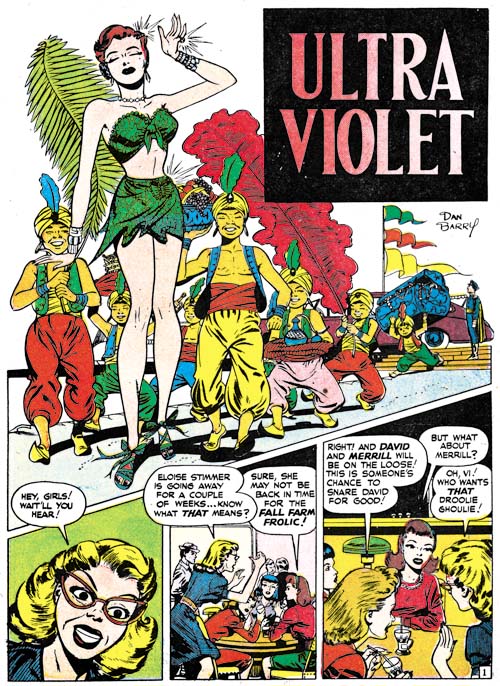
My Date #2 (September 1947) “Ultra Violet”, art by Dan Barry
The Ultra Violet features in My Date #2 and #3 were done by Dan Barry. Barry brought to the feature a more finished and elaborate style but I rather liked the original artist.
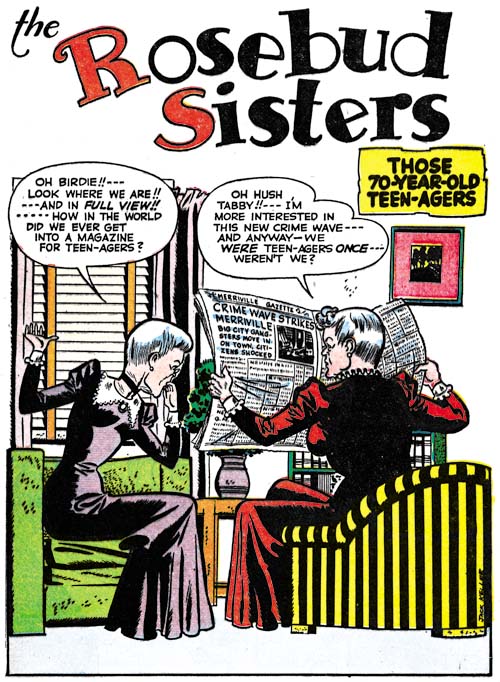
My Date #2 (September 1947) “The Rosebud Sisters”, art by Jack Keeler
My Date included stories that only appeared once. Was that intentional or were they tryouts that were judged to be unsuccessful? One unusual story was “The Rosebud Sisters”. Since the story is about a couple of elderly woman it seems very out of place in a comic devoted to teenage humor. The oddness of including this story was obvious even then since it was subtitled “Those 70-Year-Old Teen-Agers”. Fortunately the art was signed by Jack Keeler otherwise I never would have recognized it. Keeler had worked with Simon and Kirby previously having provided some 3 page Junior Genius stories for Stuntman. The Junior Genius was one of those humor strips with rather cartoony type of drawing. Keeler drew “The Rosebud Sisters” more realistically without completely loosing the cartoon-like effect.
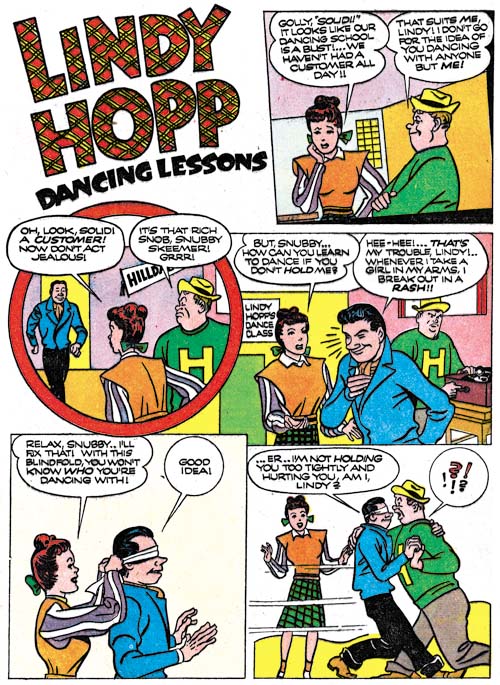
My Date #2 (September 1947) “Lindy Hopp Dancing Lessons”, art by unidentified artist
Another curious feature is “Lindy Hopp Dancing Lessons” from My Date #2. What is unusual about it is although it clearly was not drawn by either Jack Kirby or Joe Simon it includes two characters from “My Date with Swifty Chase”. The boy in the green sweater and yellow hat is clearly Bumpy although he is referred to as Soud. Snubby Skeemer is correctly named but in this strip he will not hold a girl because when he does he breaks out in a rash. This is hardly consistent with his portrayal in the Swifty Chase stories.

My Date #3 (November 1947) “Date Snatcher”, art by unidentified artist
While recognizing My Date was not a romance comic, some have called it a proto-romance. The idea being that it lead the way to the first true romance comic book, Young Romance. Personally I do not buy that argument since I feel the best prototype was just what Joe Simon claimed, the romance pulps. Almost all of My Date was teenage humor albeit primarily aimed at a young female readership. There is some justification for a label of proto-romance for a couple of stories in My Date. “Date Snatcher” (My Date #3) and “Genius, That’s What” (My Date #4) are decidedly not humor. They both deal with relations between the sexes. However there are no kisses or expressions of love although the lead character’s sister in “Date Snatcher” does get married. Like the humor stories, there is lots of dating but no romance. Still very little would have to be changed to make these true romance stories so proto-romance seems appropriate for these particular features.

My Date #4 (January 1948) “Genius, That’s What”, art by unidentified artist
I am undecided about just what level of involvement did Simon and Kirby have with My Date. I am sure the title was Joe and Jack’s brain-child. Although not belonging to the romance genre, My Date was clearly aimed at teenage girls which was the same audience intended for the romance comic that Simon and Kirby were proposing at this time. All the covers were by Kirby except the last one which was by Jerry Robinson and Mort Meskin but that one also depicted Swifty Chase, Sunny Daye and House-Date Harry. Further the first story in the comic was always by Simon and Kirby. In fact the only art that Simon and Kirby signed for Hillman was for My Date and the Western Fighters #1 cover. All that would suggest that My Date was produced by Joe Simon and Jack Kirby. But not everything in the comic supports that thesis. Usually any new Simon and Kirby title would feature a lot of work drawn by Jack but My Date would only have one Kirby story per issue (except for My Date #4). S&K would usually provide a feature with a story title while Hillman generally only used the feature’s name and My Date followed the Hillman format. Like Sherlock Holmes’s barking dog, what is most surprising is what is not present in My Date and that is Bill Draut. Draut played an important part in earlier the Stuntman and Boy Explorers comics and would again in Young Romance but he is completely absent from My Date. The only artist that worked with Joe and Jack previously was Jack Keeler and he only shows up once. I am not sure what to say about Dan Barry. Barry appeared in a number of Hillman titles in about the same time. Did Simon and Kirby introduce Dan to Hillman or was it the other way around? I am unfamiliar with the rest of the My Date artists and do not believe any of them did work for Simon and Kirby later. All in all there is a least a suggestion the Simon and Kirby did not have the full creative control over My Date that they obviously had with titles that they produced for Prize.
News on Titan’s Simon & Kirby books
As I warned previously, I am not going to be the one to break any news about Titan’s Simon & Kirby book projects. But the Jack Kirby Weblog has a post about some new information. Not much but it is better then nothing.
Marvel Reprints or Marvel Recreations?
Dan Best has an interesting post on his blog 20th Century Danny Boy. It is Original Art Stories: Marvel Masterworks Non-Original Artists. In it he discusses Marvel’s policy of re-creating art when the original stats are not available. It sounds like it is a lot more prevalent then I originally believed. I once wrote a post about Marvel’s reprint of the Human Torch #2 (1). In it I used the term re-inked, but in all honesty re-created is a more accurate description.
Admittedly the original comics were printed with a very primitive type of press. I understand why Marvel would want to use stats when available rather then the original comics. But when original stats are not available the idea that a re-creation is superior to restoring from the original comics is just bizarre. Any re-creation no matter how skillfully done is always one artist’s interpretation of another’s work. This is true even if the original artist is used since so many years have passed. This can be misleading to any comic art historian trying to understand the style of the original penciler or inker. What is worse is Marvel does not even provide any indication as to what stories are based on stats and what are re-creations.
The Real Reason for the Decline of Comics
When I reviewed Michelle Nolan’s recent book, “Love on the Racks”, I mentioned that I sometimes had trouble keeping track of the numbers that she would cite to illustrate the ups and downs of romance comics. I therefore resolved to try to make a graphic presentation. I used the data collected by Dan Stevenson found in “All the Romance Comics Ever Published (?)”. As I previously described, what I have done was followed the time during which each romance title appeared and counted up the number of titles that could be expected to be out each month. Bimonthlies were treated as being out in the in-between months (it is not an unreasonable assumption that they would actually stayed on the racks for a couple of months).
Tracking the number of titles provides an indirect indication of the popularity of the romance genre over time. After all if a title sells well enough a publisher is likely to introduce a new one in the same genre, while if sales are poor the title is likely to be cancelled. Thus in such a free market the number of titles is a fair reflection of the popularity of romance comics. There is one important caveat to this statement and that has to do with response time. With comic books it took one to two months to prepare the art, a month for the printing, and another month for the distribution. Comic books were released on assignment and profits were based on the comics actually sold. The publisher would not know how well a particular issue sold for at least a couple of months, if not more. This means that by the time the first indications reached a publisher of how successful a new title was there already may have been as many as four issues released (assuming it is a monthly). Further a publisher might want to give a new title a chance to gain its audience so even further issues might be issued before a poorly selling title might be cancelled.
The lag between release of a new title and the cancellation if it sold poorly is the explanation for the love glut. I previously showed the graph just for the glut itself but the above chart for the entire history of romance comics puts it into a better perspective. The rapidness of the ascent, the height achieved, and the quickness of the decline are unmatched in any other period. Probably unmatched by any other comic book genre as well.
As interesting and distinct as the love glut is revealed in this graph, there are other features that call for explanation. Initially I thought to divide up the chart into three distinct periods. The first period would begin with the love glut and last until early in 1957. The ending for the second period is not as distinct but could be placed between 1963 and early 1965. The final period lasted until late 1977 when the romance genre disappeared. The two small blips (1979/80 and 1982/83) are nothing more then failed revival attempts.
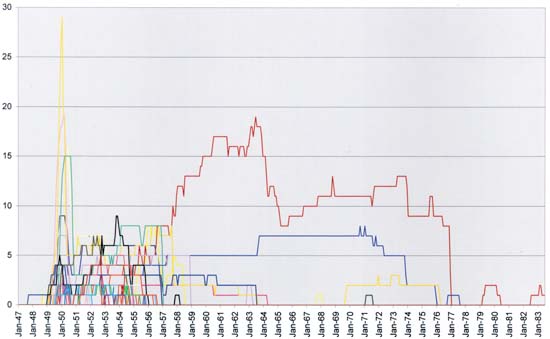
Romance Titles for All Publishers
Different colors are used for the graphs of the individual publishers
I also plotted the number of romance titles for each publisher. Now the reader should not strain themselves trying to understand the ups and downs of the individual publishers. Even with a much larger image then the one I provide above I could never truly distinguish what was going on. This chart does reveal some interesting features. One is how distinct the love glut was even when broken down into the individual publishers. This is because of overzealous actions of four in particular (Timely, Fox, Fawcett and Quality) who combined contributed to about two thirds of the love glut.
Although part of the chart is pure confusion it becomes more understandable from 1957 on. Initially there were a lot of different publishers pursuing the romance comic market but after 1957 their number became drastically reduced. For much of the ending period there were only two or three publishers of romance comics. I will be returning to phenomena below where I will present another way of examining it.
Perhaps the most unusual feature of the chart is the dominance of one publisher from 1957 on. This publisher released romance titles at levels that was only exceeded by Timely, Fox, Fawcett and Quality during the love glut and at one point (1963) was only surpassed by Timely’s peak. Who was the successful publisher? Well it was Charlton. In a free market the number of romance title was supposed to reflect their popularity. Does this mean during the later period Charlton love comics became the most popular of the genre even more successful then any other publisher throughout the history of the romance comics? Not really. Charlton was unique among the romance publishers in that they printed their own comics as well. Charlton would actual save money by keeping the print press continually running. Therefore the company had an incentive to publish comics that had low profits providing they were not actually losing money. Unfortunately that means Charlton is not running under quite the same version of the free market that the other publishers who would be less willing to put effort into titles that produced low profit. Therefore Charlton distorts the picture provided by the first chart.
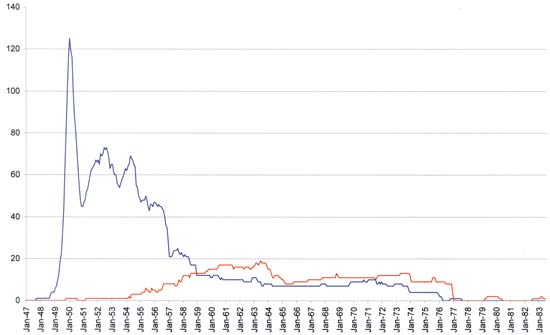
Romance Titles by Charlton and All Other Publishers
Charlton in red, all other publishers in blue
To judge how Charlton was distorting the data, I graphed Charlton separately from all other publishers. This graph shows that what I originally thought was a middle period was actually due to affects of one publisher, Charlton. It might be interesting to determine the meaning of Charlton’s downturn from 1963 to 1965 but that explanation would only enlighten Charlton’s history not to the history of romance comics in general. Therefore I now divide the history of love comics into two periods; an early or flourishing period and a final or waning period. The transition between the two periods is very sharp and that feature is unchanged whether the Charlton data is included or not.
The early period begins with the love glut and last until early in 1957. This is the heyday of romance comics. I would love to call it their golden age but that would only cause confusion as that term is often used among comics in general for an earlier period. It certainly was a good period for publishers of romance comics. Although we can see a lot of fluctuations in the number of titles there were about 50 toward the end of the prime period which is a respectable number for any genre. There are features in this period I would like to understand in particular the two mini-peaks that occurred after the love glut. Were they a similar, but more reduced, version of a phenomenon like the love glut? That is could they have been caused by publishers trying to cash into the popularity of romance comics, albeit with more caution then previously? Or was the popularity of romance comics at that time being influenced by something else as for example the general state of the economy (the trickle down effect)? At this time I have not drawn any conclusions on the matter but the subject deserves more investigation.
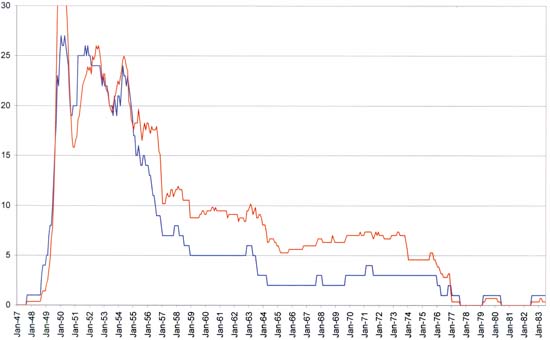
Romance Publishers and Titles
Number of romance publishers in blue, compared with a scaled version of the number of romance titles in red
When I charted the romance titles for each publisher (the second graph) there seemed to be a decline in the number of publishers at approximately the end of the flourishing period. Because that graph was much too confusing to make out the details I decided to chart the number of romance publishers which is shown just above. To help relate the variations in romance publishers to that of romance titles I included the romance titles graph scaled to approximately fit the chart of the romance publishers during the early period. As can be seen there is some good correspondence between the two charts. In particular both graphs show a rapid decline at the end of the flourishing period which terminates at the same February 1957 date. This is not too surprising because a free market affects both the number of publishers as well as the number of titles. Note however that when the number of romance titles was scaled to match the number of publishers during the flourishing period, there are proportionally more titles then publishers during the waning period. One explanation for this divergence is that those publishers who continued to do romance comics were able to increase the number of romance titles they released because of the decrease in the number of competing romance publishers. However remembering how Charlton’s desire to keep their presses running had distorted the romance title graph during the waning period I decided to compare the two graphs with Charlton removed.
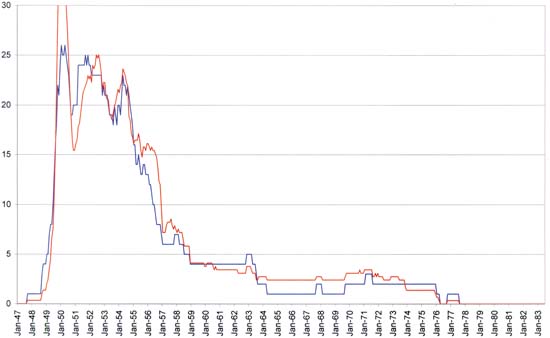
Romance Publishers and Titles Excluding Charlton
Number of romance publishers in blue, compared with a scaled version of the number of romance titles in red
Once Charlton is removed from the picture, the graphs of the number of romance publishers and the scaled version of the number of titles has become remarkably similar. Thus the number of romance publishers and the number of love titles they released both seem to be subject to a free market and both are good indicators of the popularity of love comics.
Either of the charts, including or excluding Charlton, says pretty much the same thing. In the discussion below I will be using the graphs that include Charlton. The most interesting thing about the early period is the rapid decline that ended it. From a local high of 23 romance publishers with 70 titles at June 1954 the number of publishers steadily declined until February 1957 when there were only 7 romance publishers with a total of 29 titles. While the decline in romance publisher was continuous, the decline in titles hovered around the 50 titles mark for much of this period.
It was not just romance, instead there was a decline in comics of all genre at approximately this same time. I have heard two explanations for this. One is that the blame falls on the Comic Code. The idea being that with the heavy censuring of the comic code the quality of the stories declines and many readers lost interest and stopped buying comics. The problem with this explanation is that the Comic Code stamp started appearing on comics on or about March 1955. However the rapid decline had actually started many months before.
Another explanation advanced for the decline of comics of all genres is the rise of televisions. I have two problems with this explanation. One is this presumes that entertainment is a zero sum game. That is the audience for television could not grow without taking readership away from comics. I am not convinced that is true. Secondly the American public did not suddenly buy televisions. TV’s began to appear in the late ’40s however the public’s response was not immediate but was spread out over many years. The end of the prime period occurs over much too short a time to be due to the increased dominance of televisions. So I am unsatisfied with this explanation as well.
Is there any other candidate for the decline that started after June 1954? Well actually there was. June 1954 was the peak but that meant the actual first decline started in July. The dates I have been using are cover dates, which are actually a couple of months later then the true colander date of their release. So the first decline was really in May. April 23 and 23 marked the dates for the Kefauver Senate hearings about the supposed effect of comic books on the youth of America. But the Senate hearings did not come out of the blue; they were part of the response to the public outcry brought on by the book “Seduction of the Innocents” of Dr. Frederick Wertham. There were anti-comic sentiments prior to Wertham’s book, as shown in the recent book “The Ten Cent Plague” by David Hajdu. In fact Wertham had played a part in the earlier anti-comic feelings as well. But using his status as an expert (and without any real scientific evidence) Wertham and his book incited a reaction against comic books greater then ever seen before. As I said his book led to the Kefauver Senate hearings but it had an even more immediate result. There were newsstands and other sellers of comic books that began to refuse comics they considered objectionable. This decrease in sales in turn lead to the failure of the distributor Leading News which in turn lead to the decline of some comic publishers most importantly EC. A later result was the creation of the Comic Code Authority which only made matters worse. All of this started with “Seduction of the Innocent” so the ultimate case of the collapse of comic books can be traced to one supposed expert Dr. Frederick Wertham.
But what if there was no Wertham and “Seduction of the Innocents”? Well such questions can never be answered with complete assurance. Anti-comic sentiments did exist and there were other public figures to promote them. If the previous history of comic criticism was any example then there is no reason to believe that the publishers would ever been faced with much difficulty. What seemed to be needed to bring anti-comic feelings to a significant level was some spokesman like Wirtham. There is no way of knowing whether without Wirtham some other spokesman would have arisen. But it would seem that without Wirtham at least the timing would have been altered and history would have played out differently. How different cannot be guessed.
Another question is that if comics were a free market system, why did not the publishers remaining during the waning period just increase their number of romance titles to bring the number of titles up to levels more closely approximately that of the flourishing period? The answer to that is that not all publishers and their comic titles are alike. This should not be surprising as even today collectors tend to focus on particular comics. Readers were not satisfied to read any comic on the racks but each had their own favorite titles and publishers. When particular publishers disappeared their fans were less satisfied with what remained and less likely to switch to another publisher. The drop in story quality with the Comic Code did not help matters either.
Sky Masters Color Guide, Kirby Kolors?
Ferran Delgado, who as I previously mentioned is working on a Spanish reprint of Sky Masters of the Space Force, has posted an image of a Sky Masters color guide on his blog. There is every reason to believe Jack Kirby did the coloring for the Sky Masters Sunday strips. Therefore the Sunday strips may be the only source to be able to come to a true understanding of Kirby Kolors. It is particularly nice to see an example of the actual color guide. I cannot wait for the final volume (containing the Sundays) of the Spanish Sky Masters reprints to come out.
Please Excuse Me While I Ramble On
I am in a funny situation. Since I am involved in the Titan book deal you would think this blog would be a great source for all sorts of information about the project. Actually that is far from the case. For instance I was scooped on the Titan press release. Not only that but one investigator reported on the deal months ago (and no I will not say who he was and how he did it). It is not that I do not know what is going on. Often I do (however not always) but it is not my position to pass that information along. All news about this project has come from Titan in the past that will continue to be the case in the future. I will pass information along only when it becomes official. I suspect that this blog will not be the first to report project news.
Some people have offered various types of help. It is certainly gratifying to see how willing people are to further not just this project but any that is related to Jack Kirby and Joe Simon. Unfortunately I cannot respond to those offers, at least now.
Although I cannot talk much about the project I do not think it would be wrong for me to comment about the people. I am greatly pleased about the commitment I have seen. Titan wants these volumes to be as good as possible. I do not think fans will be pleased with the books when they are released, I think they will be thrilled. I believe that is what everyone on this projects wants.
Let me wrap this up by expanding my subject matter beyond the Titan book project and talk a bit about recognition. In the past Jack Kirby did not get the credit that he should have. Sure Kirby fans knew how important Jack was, but the public at large did not have a clue. You would have thought that the blockbuster movies based on characters Kirby co-created would have changed the public’s perception (or more accurately lack thereof). But it did not happen. I think that now it is changing and I credit Mark Evanier’s book “Jack Kirby: King of Comics” with being pivotal for that change. However Jack Kirby was not the only one who did not get the recognition that he deserved, Joe Simon did not get the proper credit either. This was particularly depressing to me because some of this neglect originated from people who should have known better. The general attitude was that in the Simon and Kirby collaboration all the art tasks were handled by Jack and Joe only did the business end and some inking. I feel that this is changing as well. More and more I am hearing comments about Joe’s importance. I wish I could say that this blog was instrumental to this change but I know that simply is not the case. My readership is much too small for my efforts to have been the cause. If I am right about the shift in recognition for both Jack Kirby and Joe Simon, the future should be very exciting times for their fans.


